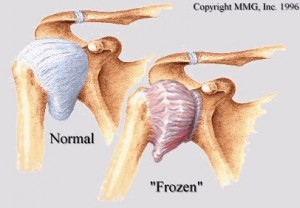What is Frozen Shoulder?
Frozen shoulder is a disorder where the connective tissue surrounding the glenohumeral joint of the shoulder becomes inflamed and stiff and abnormal bands of tissue form restricting motion and causing chronic pain.
How is it diagnosed?
The joint becomes so tight and stiff that it is nearly impossible to carry out simple movements for example raising the arm. The range of movement is severely restricted.
What are the symptoms of shoulder bursitis? How is it Diagnose?
Bursitis is typically identified by localized pain or swelling, tenderness, and pain with motion of the tissues in the affected area. X-ray testing can sometimes detect calcifications in the bursa when bursitis has been chronic or recurrent. MRI scanning (magnetic resonance imaging) can also define bursitis.
What are the causes?
The cause for frozen shoulder is unknown. Nonetheless, there are a number of risk factors which includes diabetes, stroke, accidents, lung disease, connective tissue disorders, and heart disease.
What to prevent Frozen Shoulder?
To prevent shoulder pain due to frozen shoulder, a common recommendation is to keep the shoulder joint fully moving. Often a shoulder will hurt when it begins to freeze.
What are the treatments?
The treatment is a combination of medication, physiotherapy and home exercise. Some patients require manipulation of the shoulder joint under anaesthesia to break down the abnormal tissue bands. Arthroscopic debridement of the scar tissue may be necessary for more severe cases.






